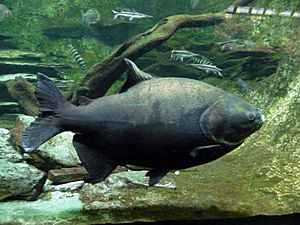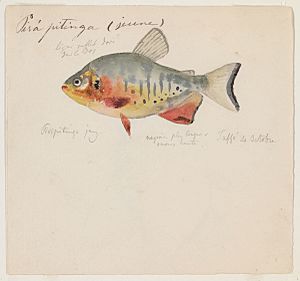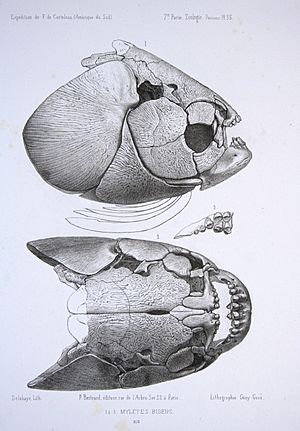Pirapitinga facts for kids
Quick facts for kids Pirapitinga |
|
|---|---|
 |
|
| Adult Piaractus brachypomus | |
| Scientific classification | |
| Genus: |
Piaractus
|
| Species: |
brachypomus
|
| Synonyms | |
|
Colossoma bidens |
|
The pirapitinga (scientific name: Piaractus brachypomus) is a large type of fish. It belongs to the pacu group, which are close relatives of piranhas and silver dollar fish. All these fish are part of the serrasalmid family.
This fish naturally lives in the Amazon basin in South America. However, a similar fish found in the Orinoco River was identified as a different species in 2019, called P. orinoquensis. People also raise pirapitinga widely in fish farms. Because of this, they have been introduced to other places. For example, in South Florida, they are now found in rivers, canals, and lakes where they are not native.
Many people call Piaractus brachypomus the red-bellied pacu. This name comes from how the young fish look. This has caused some confusion, as people often mix up the pirapitinga with other similar fish.
Life in the Wild
The pirapitinga acts a lot like its close relative, the tambaqui (Colossoma macropomum). It is a migratory fish, meaning it moves from one place to another. However, scientists don't fully understand its migration patterns yet.
The fish lay their eggs, a process called spawning, when the flood season begins. This usually happens between November and February. Young pirapitinga larvae are found in whitewater rivers. But adult fish mostly live in flooded forests and floodplains. They can be found in different types of rivers, whether the water has many nutrients or few. Unlike the tambaqui, the pirapitinga can also live in the upper parts of rivers that don't have many nutrients.
What Pirapitinga Eat
Pirapitinga mainly eat fruits, seeds, and nuts. But they are also opportunistic eaters. This means they will eat whatever food they can find. They might also eat tiny water animals called zooplankton, Insects, crustaceans, and small fish. This happens more often during the dry season when their usual food might be harder to find.
When pirapitinga eat seeds, more seeds pass through their bodies without being damaged compared to the tambaqui. This means the pirapitinga is better at spreading seeds around. This helps new plants grow in different areas.
How Pirapitinga Look
Piaractus brachypomus can grow quite large. They can reach up to 88 cm (2.9 ft) (about 3 feet) in length. They can also weigh up to 25 kg (55 lb) (about 55 pounds).
Young pirapitinga have a bright red chest and belly. This makes them look very similar to the red-bellied piranha (Pygocentrus nattereri). However, you can tell them apart by looking at their teeth. Pirapitinga have flat, molar-like teeth, while piranhas have sharp, pointed teeth. Scientists believe the young pirapitinga copy the piranha's look to avoid being eaten by other fish. This is called Batesian mimicry.
Adult pirapitinga lose their bright red color. They look more like the tambaqui (Colossoma macropomum). But there are still ways to tell them apart. Pirapitinga have a smaller adipose fin (a small, fleshy fin on their back) that doesn't have rays. They also have differences in their teeth and the bone covering their gills, called the operculum. The pirapitinga also has a more rounded head shape. Another fish in its group, P. mesopotamicus, has smaller scales and more scales along its side (over 110).
Pirapitinga and People
The pirapitinga is an important fish for fishing. Many people catch them for food. In 1998, it was the 12th most caught fish by weight in the Brazilian Amazon. This shows how important it is to the local economy.
Pirapitinga are also often raised in aquaculture, which is like farming fish. Sometimes, people create hybrid fish by breeding pirapitinga with tambaqui in these farms. Pirapitinga can also breed with P. orinoquensis, but their offspring cannot have babies themselves.
See also
In Spanish: Cachama roja para niños



